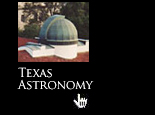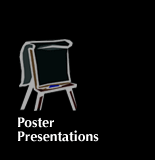Sunday, October 16th
|
7:00pm:
|
Reception (Appetizers and Drinks)
Mansion at Judges Hill
(website)
Map & Parking
(pdf)
1900 Rio Grande Blvd., (512) 495-1800
|
Monday, October 17th
|
8:45:
|
Welcoming Statements
Mary Ann Rankin, Dean, College of Natural Sciences
Don Winget, Chair, Department of Astronomy
|
|
Session I, ACES 2.302 - Judit Györgyey Ries, Chair,
bio
|
9:00-9:40:
|
Asteroids, Kuiper Belt Objects, Comets, Satellites and the Formation of Our Solar System
Scott Sheppard, Carnegie DTM
abstract
bio
|
9:40-10:20:
|
What do Multiple Planet Systems Teach Us About Planet Formation?
Eric Ford, Berkeley
abstract
bio
|
10:20-11:00:
|
Coffee & Posters, ACES 2.402
|
11:00-11:40:
|
Massive Star Formation: A Tale of Two Theories
Mark Krumholz, Princeton
abstract
bio
|
11:40-12:20:
|
Probing Chemistry During Star and Planet Formation
Jackie Kessler-Silacci, UT
abstract
bio
|
12:20-2:00:
|
Lunch* & Posters
*includes a 1 hour Q&A session
with
postdoc speakers and graduate students
|
|
Session II, ACES 2.302 - Michael Siegel, Chair,
bio
|
2:00-2:40:
|
Disks Around Young Stars
Christine Chen, NOAO
abstract
bio
|
2:40-3:20:
|
Local Interstellar Medium
Seth Redfield, UT
abstract
bio
|
3:20-4:00:
|
Coffee & Posters, ACES 2.402
|
4:00-4:40:
|
Large-scale Structures in the ISM
Naomi McClure-Griffiths, ATNF
abstract
bio
Galactic interstellar medium (ISM) studies have undergone a
renaissance in the past ten years due in part to new large-scale
surveys of the Galactic ISM. New surveys of neutral hydrogen (HI),
in particular the Canadian and Southern Galactic Plane Surveys, excel
because of their exceptional spatial dynamic range, combining
single-dish and interferometer data for arcminute resolution imaging
over areas of many degrees. These surveys are allowing us to probe
the physics of the global ISM in more detail than ever before. Among
the largest and most energetic discrete objects observed in the ISM
are HI supershells and chimneys. These objects play a pivotal,
though not fully understood, role in the Galactic ecosystem. They
heat and reshape the ISM on scales of hundreds of parsecs, making
them a significant source of structure and energy input. HI
supershells also provide convenient locations for energy dissipation
on small scales. For example, instabilities that develop along the
dense swept-up walls may be sites of cooling and molecular cloud
formation. Understanding this transition from the hot-ionized gas
presumably filling the interior of shells, to the warm neutral medium
of the outer walls, to the cold neutral medium along the small-scale
instability created features, and finally to molecular gas is crucial
to understanding the evolution of the ISM. I will present data from
the Southern Galactic Plane Survey with spatial dynamic range of 200
to 1, which allow us to study the complicated physics of supershell
evolution and to resolve the majority of the ISM life-cycle in
individual objects.
|
|
4:40-5:40:
|
Panel Discussion
|
5:40-6:30:
|
Posters, Informal Discussion
|
7:30pm:
|
Conference Dinner at Fonda San Miguel
Map & Parking
(pdf)
2330 W. North Loop, (512) 459-4121
|
Tuesday, October 18th
|
|
Session III, ACES 2.302 - Martin Landriau, Chair,
bio
|
9:00-9:40:
|
Stellar Abundances: Recent and Foreseeable Trends
Carlos Allende-Prieto, UT
abstract
bio
|
9:40-10:20:
|
Black Holes
Jon Miller, Univ. Michigan
abstract
bio
|
10:20-11:00:
|
Coffee & Posters, ACES 2.402
|
11:00-11:40:
|
Jets and Accretion in Microquasars and in AGN
Sera Markoff, MIT
abstract
bio
|
11:40-12:20:
|
Galactic Chemical Evolution
Yeshe Fenner, CfA
abstract
bio
|
12:20-2:00:
|
Lunch* & Posters
*includes a 1 hour Q&A session
with
postdoc speakers and graduate students
|
|
Session IV - Niv Drory, Chair,
bio
|
2:00-2:40:
|
The N-body Approach to Disk Galaxy Evolution
Victor Debattista, Univ. Washington
abstract
bio
|
2:40-3:20:
|
Galaxy Formation
Eric Gawiser, Yale
abstract
bio
|
3:20-4:00:
|
Coffee & Posters, ACES 2.402
|
4:00-4:40:
|
Lyman-alpha Forest as a Cosmological Probe
Matteo Viel, IoA
abstract
bio
|
4:40-5:40:
|
Panel Discussion
|
5:40-6:00:
|
Concluding Remarks
David Lambert, Director, McDonald Observatory
Frank Bash, Professor, Department of Astronomy
|
6:00-6:30:
|
Posters, Informal Discussion
|
Evening:
|
Informal "Night on the Town"
|


